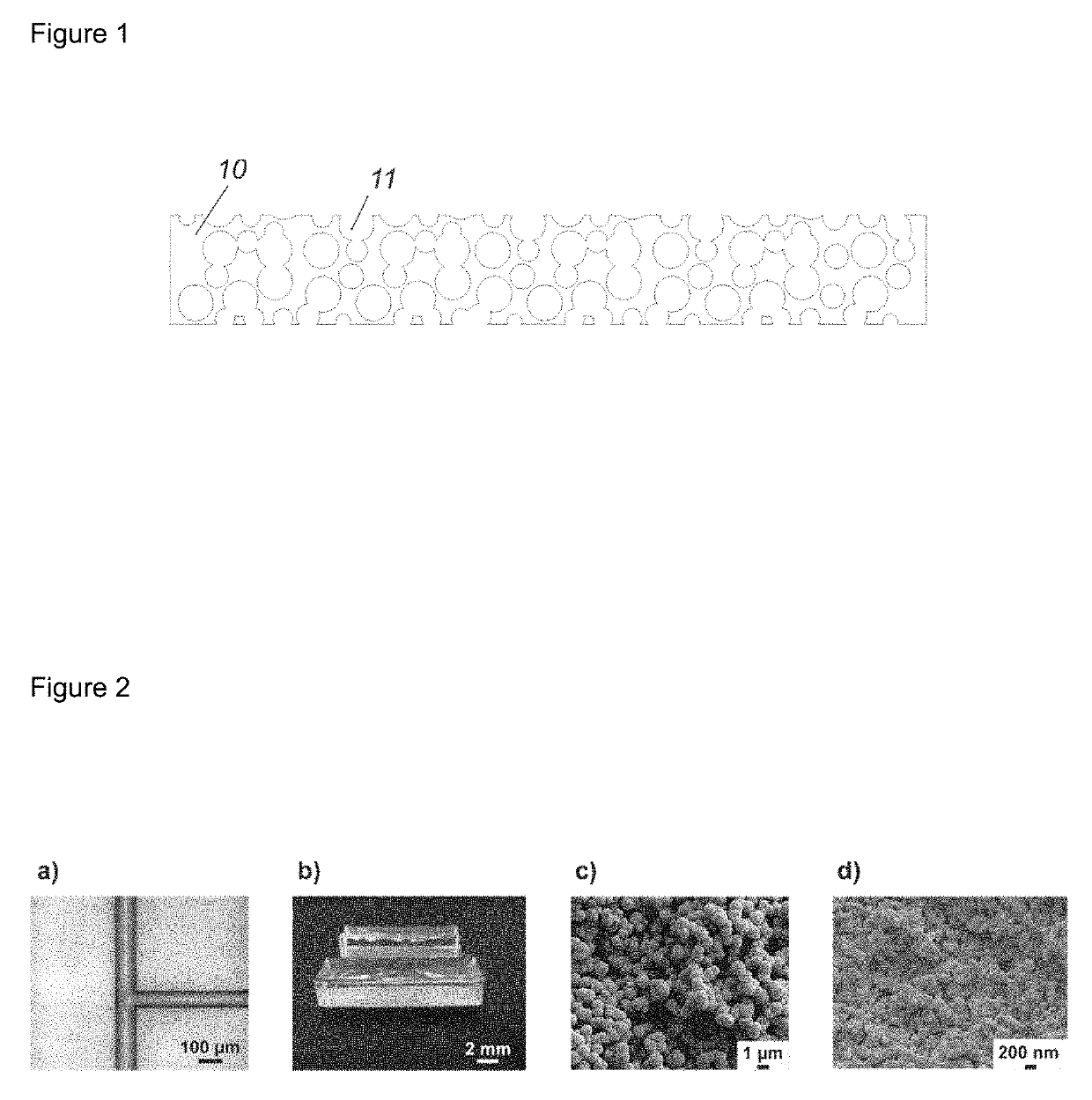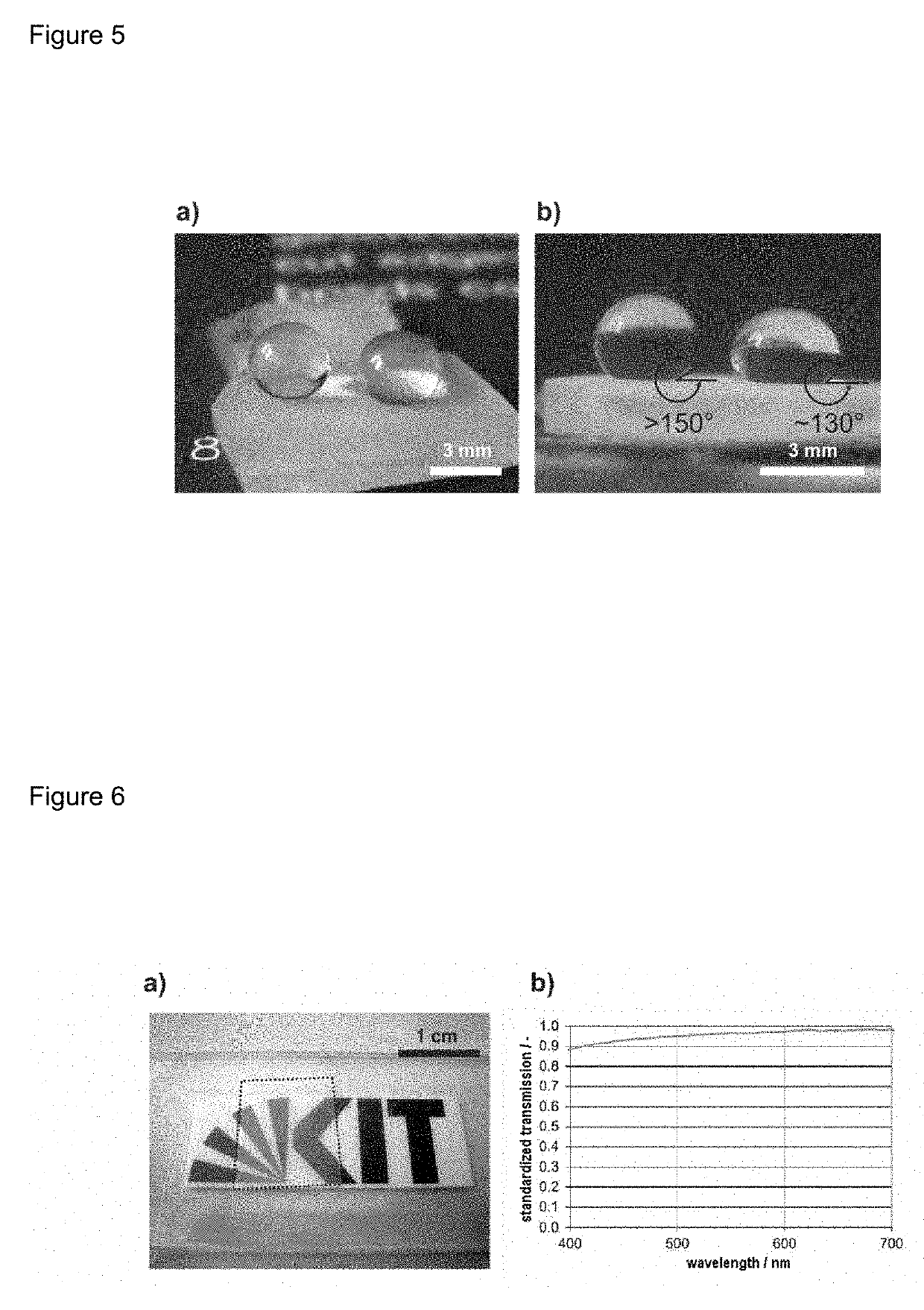Highly fluorinated nanostructured polymer foams for producing super-repellent surfaces
- Summary
- Abstract
- Description
- Claims
- Application Information
AI Technical Summary
Benefits of technology
Problems solved by technology
Method used
Image
Examples
example 1
[0091]0.214 mmol of a commercially available diacrylate derivative (Fluorolink MD 700) were mixed with 0.243 mmol 1H,1H,2H,2H perfluorooctanol, 0.449 mmol cyclohexanol and 0.006 mmol 2,2-dimethoxy-2-phenylacetophenone. The composition was cured under UV light (370 nm) for a duration of 2 min. The polymer foam obtained in this manner was dipped in isopropanol for 16 hours and then dried in an oven for 80° C. for one hour.
[0092]The polymer foam was super-hydrophobic, transparent with a slight turbidity and had a contact angle of 138° for dimethyl sulfoxide. Furthermore, the polymer foam between 400 and 800 nm had an optical transmission of 58.2% to 91.9% at a thickness of 0.25 mm.
[0093]As a reference, the non-porous form of the polymer foam had a free surface energy of 17.4 mN / m at a density of 1.692 g / mL (+ / −0.112 g / mL, three measurements). In contrast, the porous form of the polymer foam had a free surface energy of 2.939 mN / m at a density of 1.660 g / mL (+ / −0.030 g / mL, three measure...
example 2
[0095]A monomer mixture, consisting of 1.520 mmol of 2,2,3,3,4,4,5,5,6,6,7,7,8,8,8-pentadecafluorooctylmethacrylate and 0.787 mmol of 2,2,3,3,4,4,5,5-octafluorohexyldimethacrylate was mixed with 1.299 mmol of cyclohexanol, 2.049 mmol of 1H,1H,2H,2H-perfluorooctanol, 0.086 mmol of 2,2-dimethoxy-2-phenylacetophenone and 0.681 mmol of acetone. The composition was cured under UV light (220 to 400 nm) for a duration of 5 min. The polymer foam obtained in this manner was dipped in isopropanol for one hour and then dried in an oven at 80° C. for one hour.
[0096]The polymer foam was super-hydrophobic, optically clear and had a contact angle of 102° for dimethyl sulfoxide. Furthermore, the polymer foam between 400 and 800 nm had an optical transmission of 79.9% to 91.4% at a thickness of 0.25 mm.
[0097]As a reference, the non-porous form of the polymer foam had a free surface energy of 17.47 mN / m at a density of 1.654 g / mL (+ / −0.058 g / mL, three measurements). In contrast, the porous form of th...
PUM
| Property | Measurement | Unit |
|---|---|---|
| Temperature | aaaaa | aaaaa |
| Length | aaaaa | aaaaa |
| Length | aaaaa | aaaaa |
Abstract
Description
Claims
Application Information
 Login to View More
Login to View More - R&D
- Intellectual Property
- Life Sciences
- Materials
- Tech Scout
- Unparalleled Data Quality
- Higher Quality Content
- 60% Fewer Hallucinations
Browse by: Latest US Patents, China's latest patents, Technical Efficacy Thesaurus, Application Domain, Technology Topic, Popular Technical Reports.
© 2025 PatSnap. All rights reserved.Legal|Privacy policy|Modern Slavery Act Transparency Statement|Sitemap|About US| Contact US: help@patsnap.com



